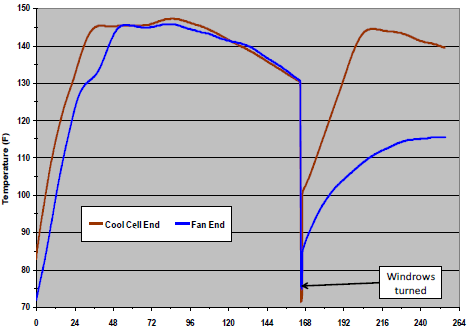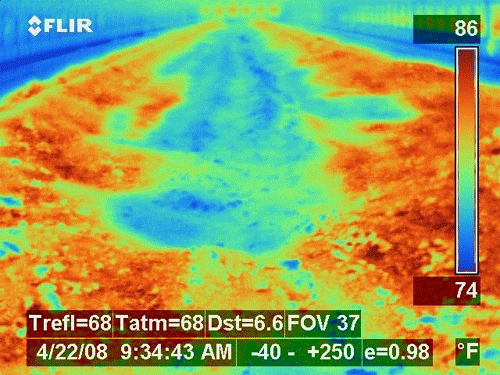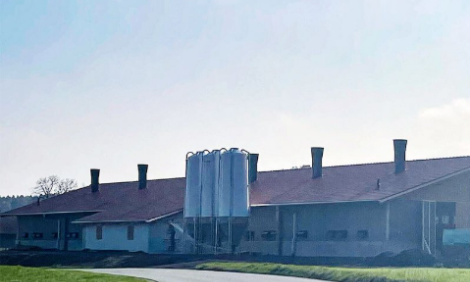



In-House Windrow Composting Q and A
A practical guide to windrow composting of broiler house litter by Dr Craig Coufal, past assistant Extension Professor, in the Summer 2008 Newsletter from the Poultry Science Department at Mississippi State University.Litter management between flocks of broilers is as critical as any other maintenance task that must be done to get the houses ready for the next batch of chicks. Proper litter management between flocks will ensure a healthy environment for the chicks and help reduce the potential for bird health problems and excessive ammonia in the house. Most broiler growers use litter management equipment such as housekeepers (cake-out machines) to remove caked litter and help control litter moisture. Often, that is all that needs to be done, and has been the industry standard for many years.

Another method of litter management that has been growing in popularity is windrow composting. This process involves piling the litter into rows (windrows) down the length of the house. This is often done simply with a tractor and blade set on an angle (Figure 1) but specialized composting equipment and skid steer loaders can also be used. The natural metabolism of the bacteria in the litter causes a composting process to begin and generates heat within the windrows. As the temperature rises, pathogenic bacteria and other microorganisms are destroyed, producing a litter material that will be well conditioned for the next batch of chicks.
The following are some of the questions that growers and company managers often ask about windrow composting. Because there has been a limited amount of research done with windrow composting to date, a precise answer based on research data to every question is difficult. However, many of the factors that must be taken into consideration are discussed.
To what is the minimum temperature the litter should be heated?
The generally accepted minimum temperature recommendation is 130°F. Most of the microorganisms pathogenic to chickens are destroyed at 130°F. The “optimum” temperature has not been established, but the general consensus among those who use windrow composting is to try to get the temperature as hot as possible. In recent trials at Mississippi State University, windrow core temperatures of 145°F were achieved in about 50 hours after the windrows were formed (Figure 2).

What is the optimum litter moisture?
It is difficult to pinpoint an optimum litter moisture value (or even a narrow range) since little experimental data correlating temperatures and moisture values have been published. In a laboratory experiment, researchers at Louisiana State University determined the minimum moisture content should be 32%, with moisture levels in field trials ranging from 25 to 37% producing adequate temperatures (Lavergne et al., 2006). Bud Malone of the University of Delaware has recommended the optimum moisture content is approximately 35%.
It is likely that the “optimum” litter moisture may very depending on other factors such as age of litter, type of litter base, nutrient content (C:N), and ambient temperature. More research is needed to more accurately define moisture requirements. Nevertheless, it is apparent that moisture plays a critical role, and higher litter moisture is usually associated with higher composting temperatures. In addition, caution must be exercised to limit moisture content since excessively wet litter will likely not adequately dry during composting, and may result in greater ammonia formation when the next flock of chicks is placed.
Should I include the caked litter into the windrows or remove the cake before windrowing?
The answer to this question may be one of personal preference. Most people who have used in-house windrowing have mixed the cake into the windrows, mainly to assure high enough moisture content. Still others have suggested removing the cake to reduce ammonia problems after composting. If caked litter is removed, water may need to be added back to assure an adequate moisture content for proper heat generation. An additional consideration is the additional time and expense of cake removal before windrowing.
Is it necessary to turn the windrows?
The answer again may be one of personal preference. The purpose of turning the windrows would be to assure that all the litter in the pile is heated to 130°F. Figure 3 is a thermal image of the windrows in the recent trial at MSU. While the image clearly shows that the litter in windrows is hotter than the floor of the house, the surface temperature is not hot enough to kill microorganisms. Therefore, in order to treat all the litter, the piles must be turned to allow the litter on the outside to be mixed into the pile where the temperature is hot. In the trial at MSU, turning also appeared to help break-up the caked litter (which had been left in) and resulted in an acceptable litter bed for the next flock without cake-out having to be performed.
An additional consideration with turning is moisture level. In Figure 2, a dramatic difference in temperature was observed between the cool cell end and the fan end of the windrows after turning at 7 days. While moisture measurements were not taken, this difference is likely due to moisture content. It was observed that the litter on the fan end of the house was much drier than the litter on the cool cell end.

(Photo by Dr Jody Purswell, USDA-ARS, Starkville, MS)
Can in-house windrow composting be done on a layout as short as 7 days?
The answer is 'theoretically, yes'. Most producer who use windrow composting have recommended more time is needed to assure proper litter drying and purging of ammonia out of the house after the piles are levelled out. Most people recommend leaving the litter piled for 5 to 7 days, plus several days to vent out moisture and ammonia after the windrows are levelled, making the total time usually 8 to 10 days. However, data indicates that maximum temperatures are achieved after 2 days and begin to decrease after 4 or 5 (Figure 2).
Theoretically, if litter was windrowed immediately after birds were removed, and windrows were levelled on the fourth or fifth day, then houses could be made ready for chicks in 7 days. However, no time would be allowed for turning of windrows, and cake-out would likely need to be performed prior to or after venting of ammonia would also be a concern. Additional research is needed to determine if windrow composting would actually be beneficial in such a short turn-around period.
Should I windrow compost after every flock?
This question is difficult to answer. Data has not been published directly comparing houses that have been composted after every flock versus houses that have not been. Such data would be difficult to generate and would required several flock comparisons over many farms. Improved performance and bird health has been reported in subsequent flocks after windrow composting has been performed (Malone, 2007).
If litter quality is good and no health issues have been observed in previous flocks, then it is likely that little benefit may be obtained from windrow composting. On the other hand, composting could also be viewed as a preventative measure to ensure good litter quality for the next flock.
How long does it take to windrow a house?
Most people in Mississippi use their ordinary farm tractor and a three-point hitch blade set on an angle to form windrows. This method was used in the trial at MSU. A good tractor operator should be able to form two windrows in a house in 1 to 1.5 hours. Also, remember that an approximately equal amount of time will likely be needed to level the windrows before preparing the house for chicks.
References:
Lavergne, T.K., M.F. Stephens, D. Schellinger and W.A. Carney, Jr., 2006. In-house pasteurization of broiler litter. Louisiana State University Agricultural Center Publication #2955.
Malone, 2007. In-house composting of Litter. Delmarva Poultry Industry, Inc Timely Topics. December 2007. 24 (4): 7-8.








